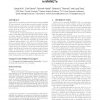Free Online Productivity Tools
i2Speak
i2Symbol
i2OCR
iTex2Img
iWeb2Print
iWeb2Shot
i2Type
iPdf2Split
iPdf2Merge
i2Bopomofo
i2Arabic
i2Style
i2Image
i2PDF
iLatex2Rtf
Sci2ools
WISEC
2010
ACM
2010
ACM
Timing-based localization of in-band wormhole tunnels in MANETs
The problem of localizing in-band wormhole tunnels in MANETs is considered. In an in-band wormhole attack, colluding attackers use a covert tunnel to create the illusion that two remote network regions are directly connected. This apparent shortcut in the topology attracts traffic which the attackers can then control. To identify the nodes participating in the attack, it is necessary to determine the path through which victims’ traffic is covertly tunneled. This paper begins with binary hypothesis testing, which tests whether a suspected path is carrying tunneled traffic. The detection algorithm is presented and evaluated using synthetic voice over IP (VoIP) traffic generated in a network testbed. After that, we consider multiple hypothesis testing to find the most likely tunnel path among a large number of candidates. We present a tunnel path estimation algorithm and its numerical evaluation using Poisson traffic. A main feature of the proposed algorithms is their robustness again...
| Added | 14 May 2010 |
| Updated | 14 May 2010 |
| Type | Conference |
| Year | 2010 |
| Where | WISEC |
| Authors | Jinsub Kim, Dan Sterne, Rommie Hardy, Roshan K. Thomas, Lang Tong |
Comments (0)

